Healthcare Workforce Planning in Ghana: Report and Recommendations
VerifiedAdded on 2022/12/23
|19
|3468
|1
Report
AI Summary
This report presents a strategic human resources plan for Ghana's healthcare workforce, aiming to improve health worker numbers and service quality by 2030. The report begins with an executive summary, highlighting Ghana's health worker shortage and the need for improvement. It then provides an environmental scan, analyzing current policies, data comparisons, and critical issues such as workforce morale, distribution, and attrition. The report proposes a framework and strategies, including targets for different health worker categories and outlines the need for adequate funding, improved education, and cross-country workforce migration. Data analysis compares Ghana's health workforce with other countries in sub-Saharan Africa, revealing significant shortages, particularly in physicians, dentists, and pharmacists. The report also presents recommendations for addressing these challenges and achieving the strategic objectives of strengthening healthcare systems, improving healthcare worker education and recruitment, and developing a ten-year funding plan. The ultimate goal is to enhance healthcare access, equity, and quality for the population.
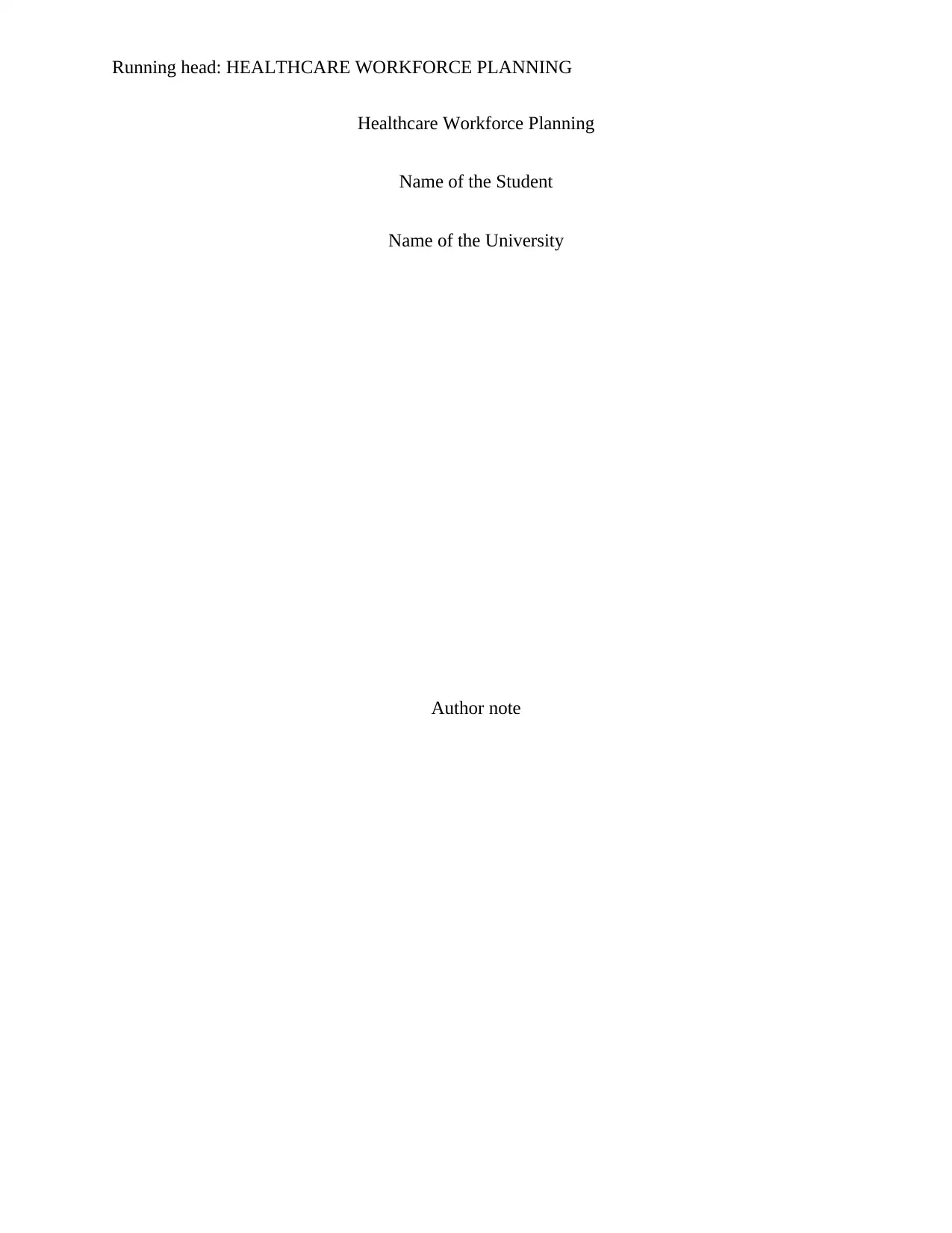
Running head: HEALTHCARE WORKFORCE PLANNING
Healthcare Workforce Planning
Name of the Student
Name of the University
Author note
Healthcare Workforce Planning
Name of the Student
Name of the University
Author note
Paraphrase This Document
Need a fresh take? Get an instant paraphrase of this document with our AI Paraphraser
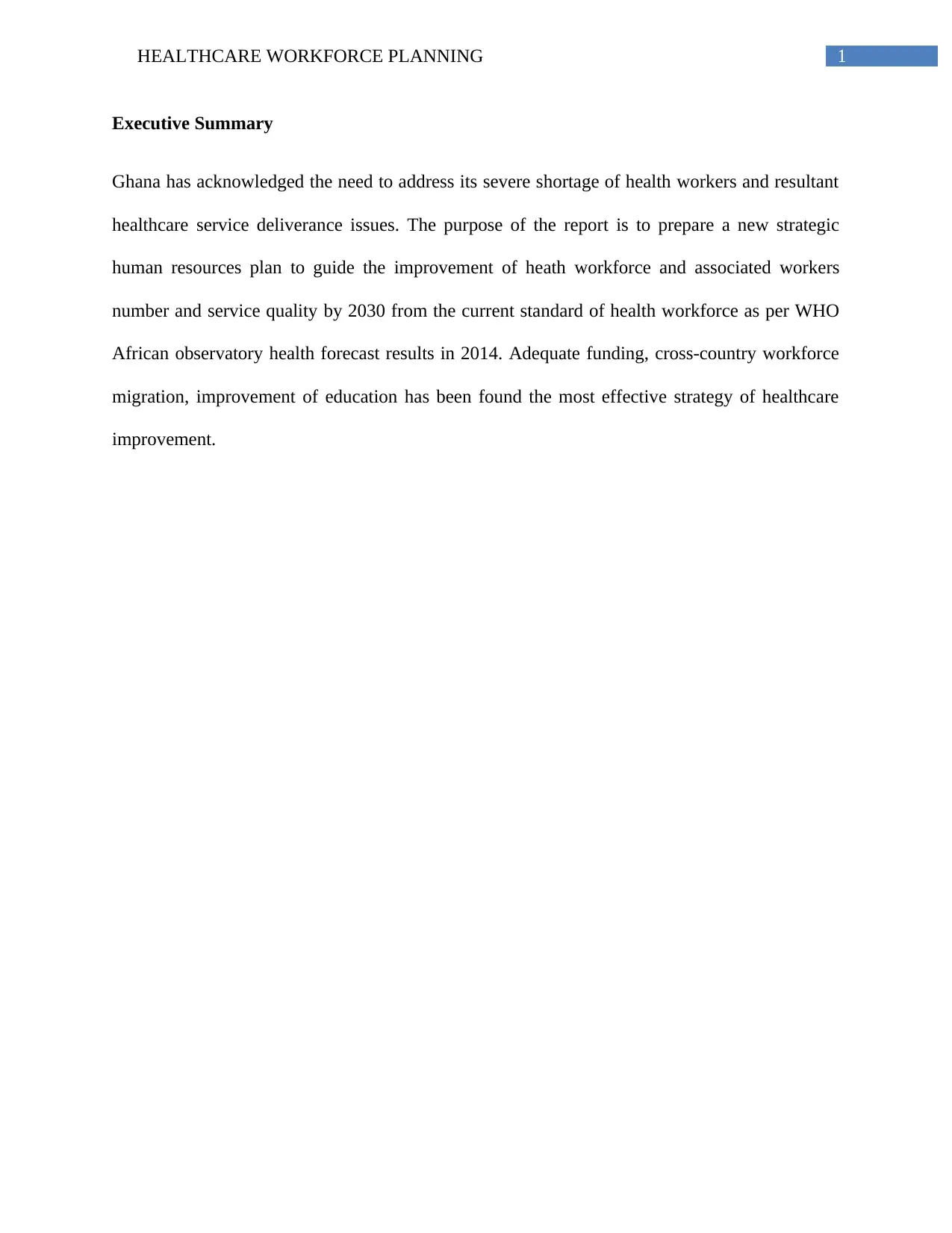
1HEALTHCARE WORKFORCE PLANNING
Executive Summary
Ghana has acknowledged the need to address its severe shortage of health workers and resultant
healthcare service deliverance issues. The purpose of the report is to prepare a new strategic
human resources plan to guide the improvement of heath workforce and associated workers
number and service quality by 2030 from the current standard of health workforce as per WHO
African observatory health forecast results in 2014. Adequate funding, cross-country workforce
migration, improvement of education has been found the most effective strategy of healthcare
improvement.
Executive Summary
Ghana has acknowledged the need to address its severe shortage of health workers and resultant
healthcare service deliverance issues. The purpose of the report is to prepare a new strategic
human resources plan to guide the improvement of heath workforce and associated workers
number and service quality by 2030 from the current standard of health workforce as per WHO
African observatory health forecast results in 2014. Adequate funding, cross-country workforce
migration, improvement of education has been found the most effective strategy of healthcare
improvement.
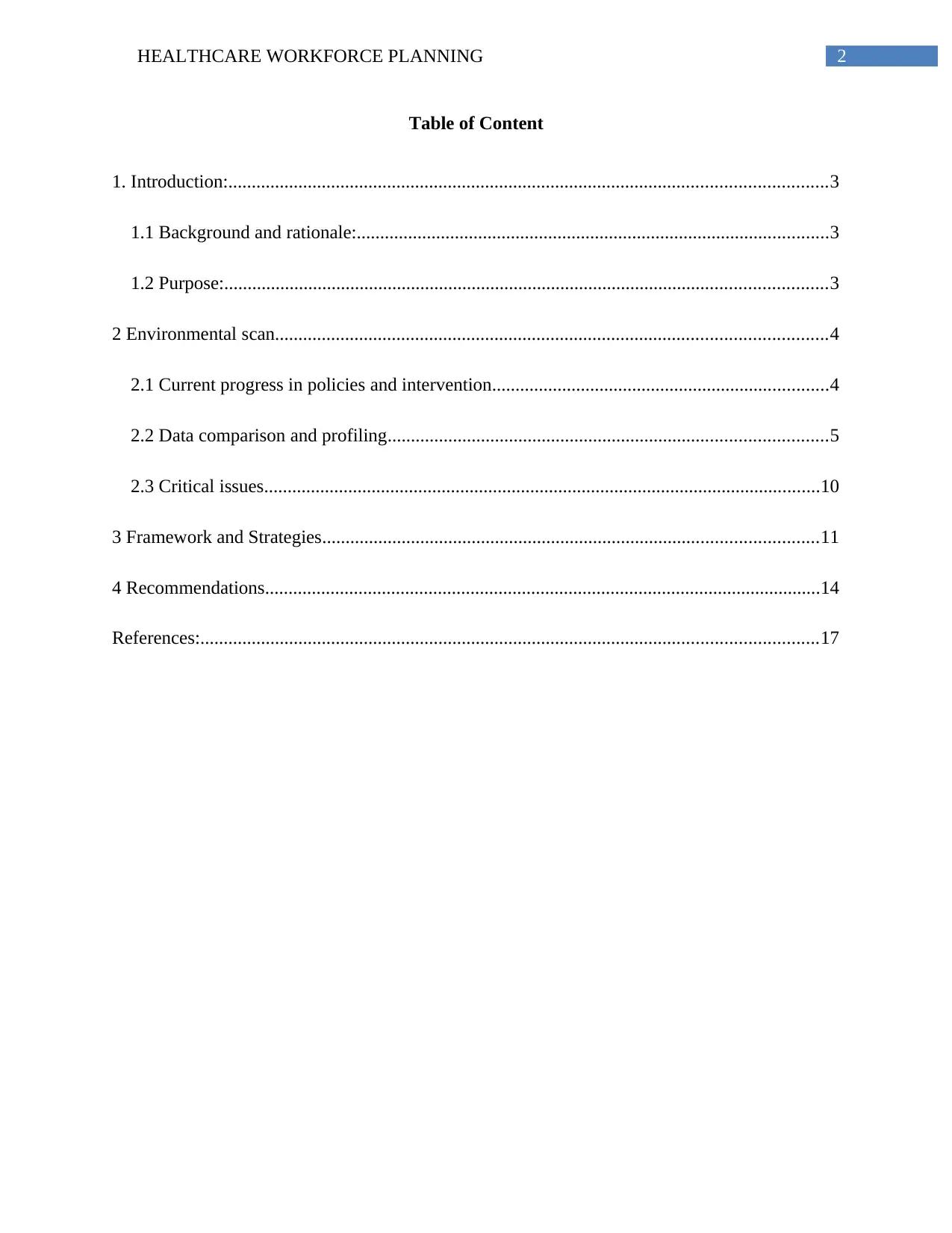
2HEALTHCARE WORKFORCE PLANNING
Table of Content
1. Introduction:................................................................................................................................3
1.1 Background and rationale:.....................................................................................................3
1.2 Purpose:.................................................................................................................................3
2 Environmental scan......................................................................................................................4
2.1 Current progress in policies and intervention........................................................................4
2.2 Data comparison and profiling..............................................................................................5
2.3 Critical issues.......................................................................................................................10
3 Framework and Strategies..........................................................................................................11
4 Recommendations.......................................................................................................................14
References:....................................................................................................................................17
Table of Content
1. Introduction:................................................................................................................................3
1.1 Background and rationale:.....................................................................................................3
1.2 Purpose:.................................................................................................................................3
2 Environmental scan......................................................................................................................4
2.1 Current progress in policies and intervention........................................................................4
2.2 Data comparison and profiling..............................................................................................5
2.3 Critical issues.......................................................................................................................10
3 Framework and Strategies..........................................................................................................11
4 Recommendations.......................................................................................................................14
References:....................................................................................................................................17
⊘ This is a preview!⊘
Do you want full access?
Subscribe today to unlock all pages.

Trusted by 1+ million students worldwide
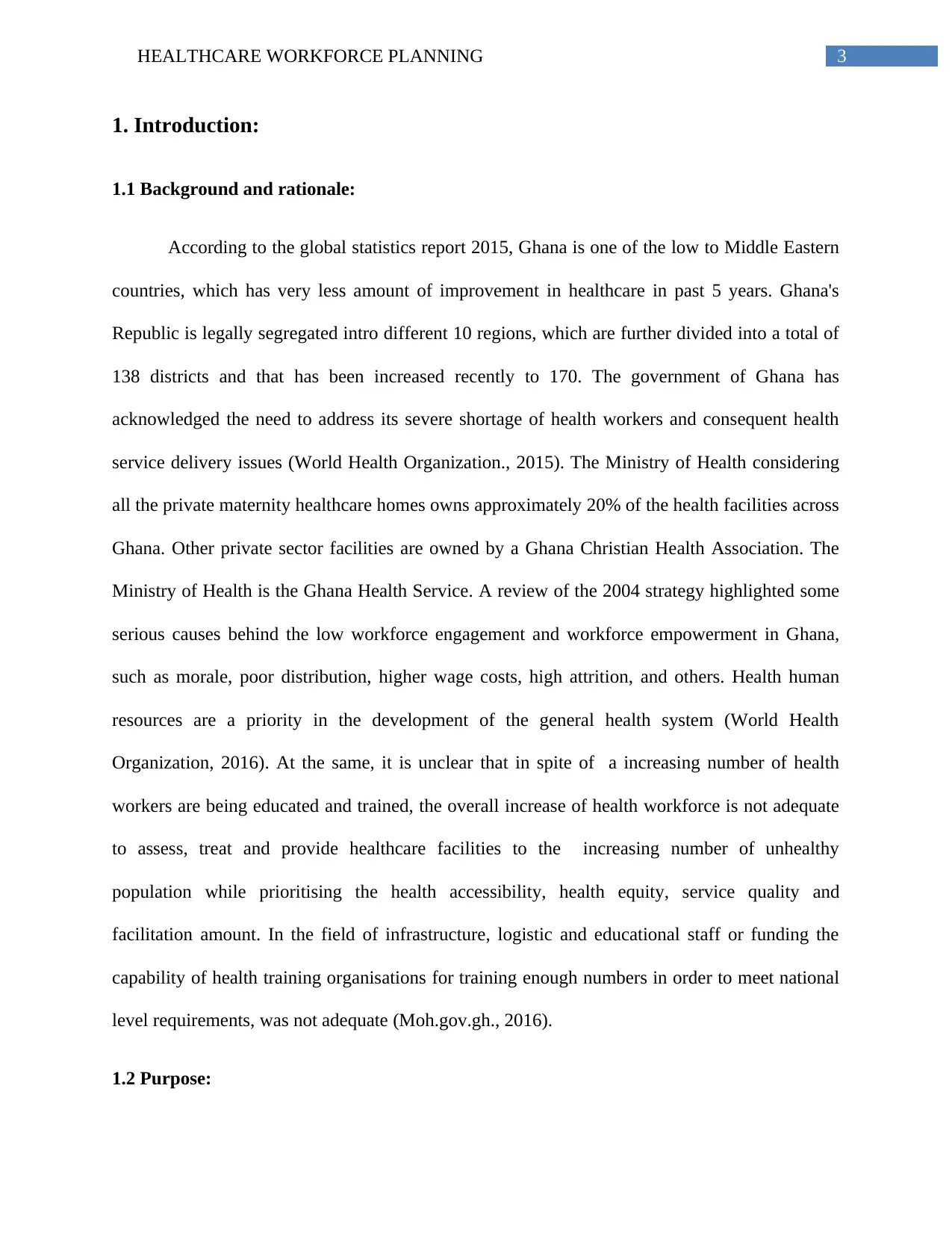
3HEALTHCARE WORKFORCE PLANNING
1. Introduction:
1.1 Background and rationale:
According to the global statistics report 2015, Ghana is one of the low to Middle Eastern
countries, which has very less amount of improvement in healthcare in past 5 years. Ghana's
Republic is legally segregated intro different 10 regions, which are further divided into a total of
138 districts and that has been increased recently to 170. The government of Ghana has
acknowledged the need to address its severe shortage of health workers and consequent health
service delivery issues (World Health Organization., 2015). The Ministry of Health considering
all the private maternity healthcare homes owns approximately 20% of the health facilities across
Ghana. Other private sector facilities are owned by a Ghana Christian Health Association. The
Ministry of Health is the Ghana Health Service. A review of the 2004 strategy highlighted some
serious causes behind the low workforce engagement and workforce empowerment in Ghana,
such as morale, poor distribution, higher wage costs, high attrition, and others. Health human
resources are a priority in the development of the general health system (World Health
Organization, 2016). At the same, it is unclear that in spite of a increasing number of health
workers are being educated and trained, the overall increase of health workforce is not adequate
to assess, treat and provide healthcare facilities to the increasing number of unhealthy
population while prioritising the health accessibility, health equity, service quality and
facilitation amount. In the field of infrastructure, logistic and educational staff or funding the
capability of health training organisations for training enough numbers in order to meet national
level requirements, was not adequate (Moh.gov.gh., 2016).
1.2 Purpose:
1. Introduction:
1.1 Background and rationale:
According to the global statistics report 2015, Ghana is one of the low to Middle Eastern
countries, which has very less amount of improvement in healthcare in past 5 years. Ghana's
Republic is legally segregated intro different 10 regions, which are further divided into a total of
138 districts and that has been increased recently to 170. The government of Ghana has
acknowledged the need to address its severe shortage of health workers and consequent health
service delivery issues (World Health Organization., 2015). The Ministry of Health considering
all the private maternity healthcare homes owns approximately 20% of the health facilities across
Ghana. Other private sector facilities are owned by a Ghana Christian Health Association. The
Ministry of Health is the Ghana Health Service. A review of the 2004 strategy highlighted some
serious causes behind the low workforce engagement and workforce empowerment in Ghana,
such as morale, poor distribution, higher wage costs, high attrition, and others. Health human
resources are a priority in the development of the general health system (World Health
Organization, 2016). At the same, it is unclear that in spite of a increasing number of health
workers are being educated and trained, the overall increase of health workforce is not adequate
to assess, treat and provide healthcare facilities to the increasing number of unhealthy
population while prioritising the health accessibility, health equity, service quality and
facilitation amount. In the field of infrastructure, logistic and educational staff or funding the
capability of health training organisations for training enough numbers in order to meet national
level requirements, was not adequate (Moh.gov.gh., 2016).
1.2 Purpose:
Paraphrase This Document
Need a fresh take? Get an instant paraphrase of this document with our AI Paraphraser
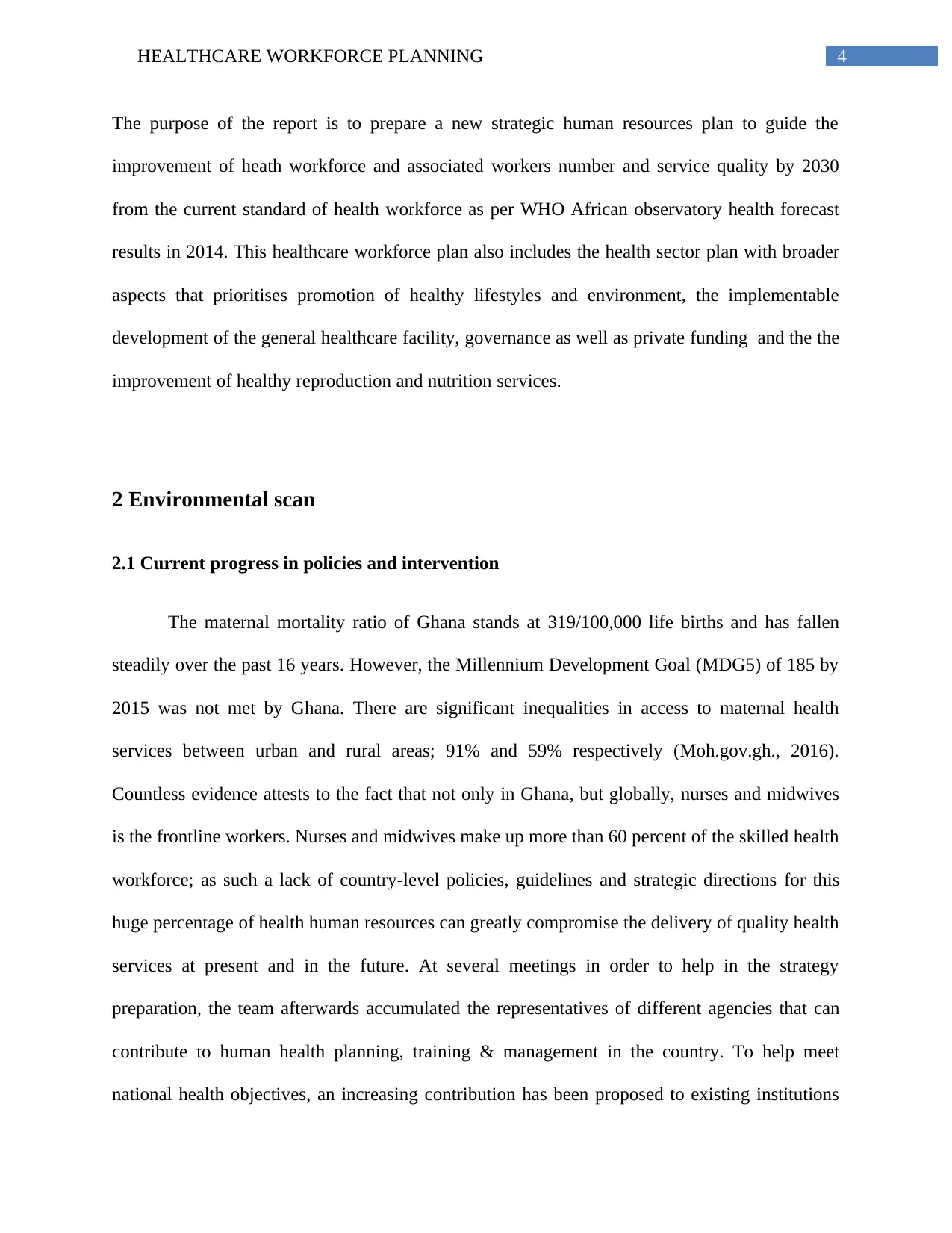
4HEALTHCARE WORKFORCE PLANNING
The purpose of the report is to prepare a new strategic human resources plan to guide the
improvement of heath workforce and associated workers number and service quality by 2030
from the current standard of health workforce as per WHO African observatory health forecast
results in 2014. This healthcare workforce plan also includes the health sector plan with broader
aspects that prioritises promotion of healthy lifestyles and environment, the implementable
development of the general healthcare facility, governance as well as private funding and the the
improvement of healthy reproduction and nutrition services.
2 Environmental scan
2.1 Current progress in policies and intervention
The maternal mortality ratio of Ghana stands at 319/100,000 life births and has fallen
steadily over the past 16 years. However, the Millennium Development Goal (MDG5) of 185 by
2015 was not met by Ghana. There are significant inequalities in access to maternal health
services between urban and rural areas; 91% and 59% respectively (Moh.gov.gh., 2016).
Countless evidence attests to the fact that not only in Ghana, but globally, nurses and midwives
is the frontline workers. Nurses and midwives make up more than 60 percent of the skilled health
workforce; as such a lack of country-level policies, guidelines and strategic directions for this
huge percentage of health human resources can greatly compromise the delivery of quality health
services at present and in the future. At several meetings in order to help in the strategy
preparation, the team afterwards accumulated the representatives of different agencies that can
contribute to human health planning, training & management in the country. To help meet
national health objectives, an increasing contribution has been proposed to existing institutions
The purpose of the report is to prepare a new strategic human resources plan to guide the
improvement of heath workforce and associated workers number and service quality by 2030
from the current standard of health workforce as per WHO African observatory health forecast
results in 2014. This healthcare workforce plan also includes the health sector plan with broader
aspects that prioritises promotion of healthy lifestyles and environment, the implementable
development of the general healthcare facility, governance as well as private funding and the the
improvement of healthy reproduction and nutrition services.
2 Environmental scan
2.1 Current progress in policies and intervention
The maternal mortality ratio of Ghana stands at 319/100,000 life births and has fallen
steadily over the past 16 years. However, the Millennium Development Goal (MDG5) of 185 by
2015 was not met by Ghana. There are significant inequalities in access to maternal health
services between urban and rural areas; 91% and 59% respectively (Moh.gov.gh., 2016).
Countless evidence attests to the fact that not only in Ghana, but globally, nurses and midwives
is the frontline workers. Nurses and midwives make up more than 60 percent of the skilled health
workforce; as such a lack of country-level policies, guidelines and strategic directions for this
huge percentage of health human resources can greatly compromise the delivery of quality health
services at present and in the future. At several meetings in order to help in the strategy
preparation, the team afterwards accumulated the representatives of different agencies that can
contribute to human health planning, training & management in the country. To help meet
national health objectives, an increasing contribution has been proposed to existing institutions
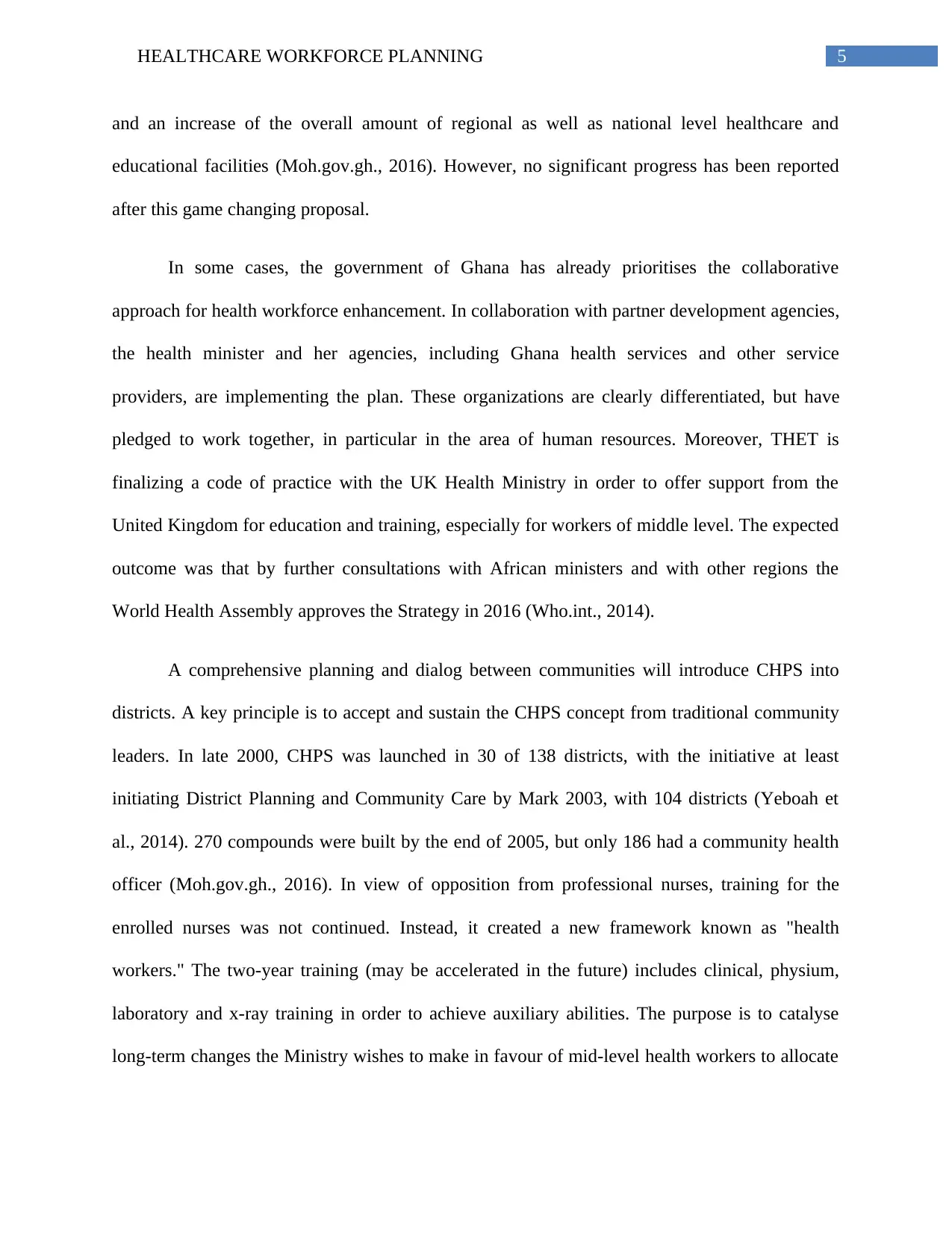
5HEALTHCARE WORKFORCE PLANNING
and an increase of the overall amount of regional as well as national level healthcare and
educational facilities (Moh.gov.gh., 2016). However, no significant progress has been reported
after this game changing proposal.
In some cases, the government of Ghana has already prioritises the collaborative
approach for health workforce enhancement. In collaboration with partner development agencies,
the health minister and her agencies, including Ghana health services and other service
providers, are implementing the plan. These organizations are clearly differentiated, but have
pledged to work together, in particular in the area of human resources. Moreover, THET is
finalizing a code of practice with the UK Health Ministry in order to offer support from the
United Kingdom for education and training, especially for workers of middle level. The expected
outcome was that by further consultations with African ministers and with other regions the
World Health Assembly approves the Strategy in 2016 (Who.int., 2014).
A comprehensive planning and dialog between communities will introduce CHPS into
districts. A key principle is to accept and sustain the CHPS concept from traditional community
leaders. In late 2000, CHPS was launched in 30 of 138 districts, with the initiative at least
initiating District Planning and Community Care by Mark 2003, with 104 districts (Yeboah et
al., 2014). 270 compounds were built by the end of 2005, but only 186 had a community health
officer (Moh.gov.gh., 2016). In view of opposition from professional nurses, training for the
enrolled nurses was not continued. Instead, it created a new framework known as "health
workers." The two-year training (may be accelerated in the future) includes clinical, physium,
laboratory and x-ray training in order to achieve auxiliary abilities. The purpose is to catalyse
long-term changes the Ministry wishes to make in favour of mid-level health workers to allocate
and an increase of the overall amount of regional as well as national level healthcare and
educational facilities (Moh.gov.gh., 2016). However, no significant progress has been reported
after this game changing proposal.
In some cases, the government of Ghana has already prioritises the collaborative
approach for health workforce enhancement. In collaboration with partner development agencies,
the health minister and her agencies, including Ghana health services and other service
providers, are implementing the plan. These organizations are clearly differentiated, but have
pledged to work together, in particular in the area of human resources. Moreover, THET is
finalizing a code of practice with the UK Health Ministry in order to offer support from the
United Kingdom for education and training, especially for workers of middle level. The expected
outcome was that by further consultations with African ministers and with other regions the
World Health Assembly approves the Strategy in 2016 (Who.int., 2014).
A comprehensive planning and dialog between communities will introduce CHPS into
districts. A key principle is to accept and sustain the CHPS concept from traditional community
leaders. In late 2000, CHPS was launched in 30 of 138 districts, with the initiative at least
initiating District Planning and Community Care by Mark 2003, with 104 districts (Yeboah et
al., 2014). 270 compounds were built by the end of 2005, but only 186 had a community health
officer (Moh.gov.gh., 2016). In view of opposition from professional nurses, training for the
enrolled nurses was not continued. Instead, it created a new framework known as "health
workers." The two-year training (may be accelerated in the future) includes clinical, physium,
laboratory and x-ray training in order to achieve auxiliary abilities. The purpose is to catalyse
long-term changes the Ministry wishes to make in favour of mid-level health workers to allocate
⊘ This is a preview!⊘
Do you want full access?
Subscribe today to unlock all pages.

Trusted by 1+ million students worldwide
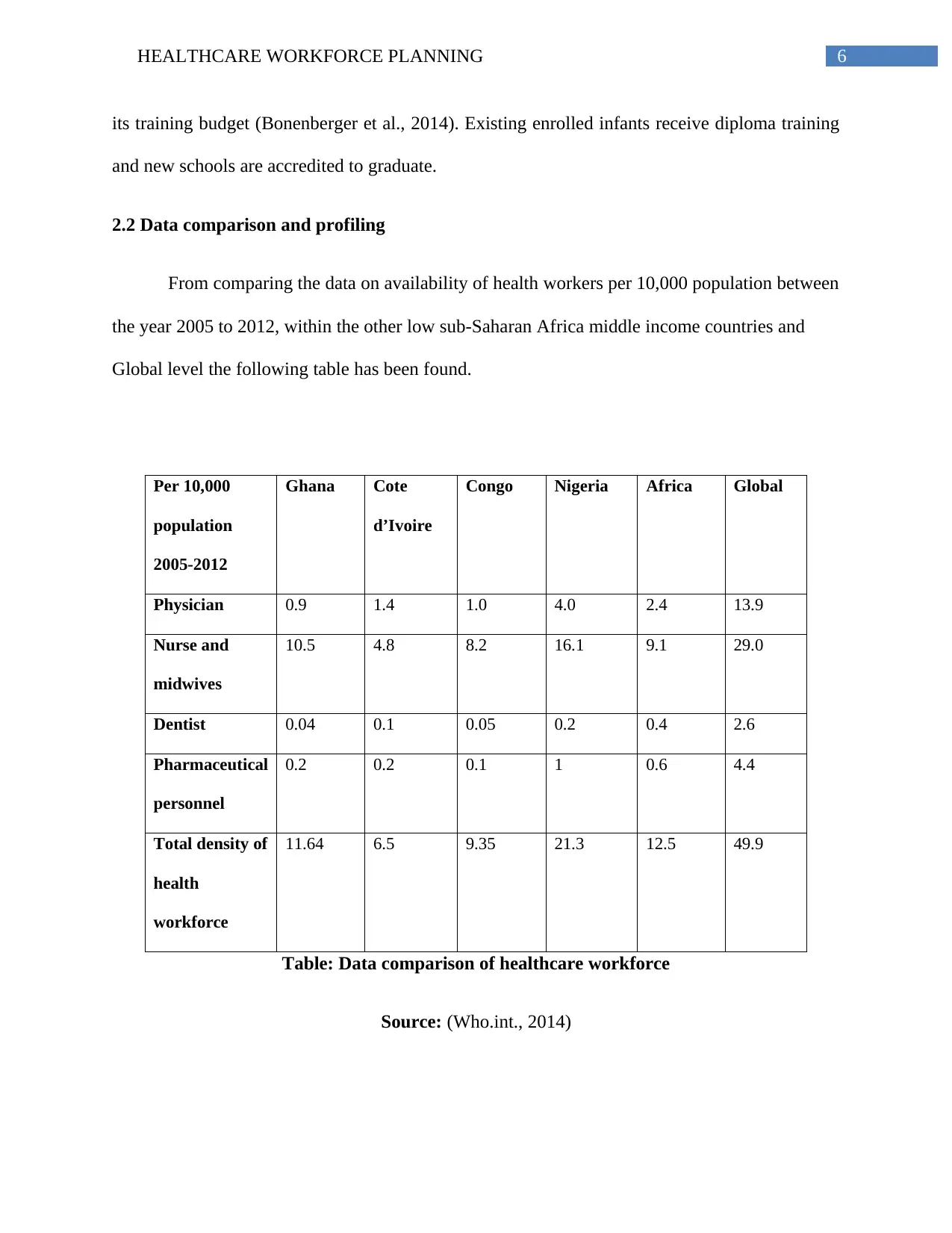
6HEALTHCARE WORKFORCE PLANNING
its training budget (Bonenberger et al., 2014). Existing enrolled infants receive diploma training
and new schools are accredited to graduate.
2.2 Data comparison and profiling
From comparing the data on availability of health workers per 10,000 population between
the year 2005 to 2012, within the other low sub-Saharan Africa middle income countries and
Global level the following table has been found.
Per 10,000
population
2005-2012
Ghana Cote
d’Ivoire
Congo Nigeria Africa Global
Physician 0.9 1.4 1.0 4.0 2.4 13.9
Nurse and
midwives
10.5 4.8 8.2 16.1 9.1 29.0
Dentist 0.04 0.1 0.05 0.2 0.4 2.6
Pharmaceutical
personnel
0.2 0.2 0.1 1 0.6 4.4
Total density of
health
workforce
11.64 6.5 9.35 21.3 12.5 49.9
Table: Data comparison of healthcare workforce
Source: (Who.int., 2014)
its training budget (Bonenberger et al., 2014). Existing enrolled infants receive diploma training
and new schools are accredited to graduate.
2.2 Data comparison and profiling
From comparing the data on availability of health workers per 10,000 population between
the year 2005 to 2012, within the other low sub-Saharan Africa middle income countries and
Global level the following table has been found.
Per 10,000
population
2005-2012
Ghana Cote
d’Ivoire
Congo Nigeria Africa Global
Physician 0.9 1.4 1.0 4.0 2.4 13.9
Nurse and
midwives
10.5 4.8 8.2 16.1 9.1 29.0
Dentist 0.04 0.1 0.05 0.2 0.4 2.6
Pharmaceutical
personnel
0.2 0.2 0.1 1 0.6 4.4
Total density of
health
workforce
11.64 6.5 9.35 21.3 12.5 49.9
Table: Data comparison of healthcare workforce
Source: (Who.int., 2014)
Paraphrase This Document
Need a fresh take? Get an instant paraphrase of this document with our AI Paraphraser
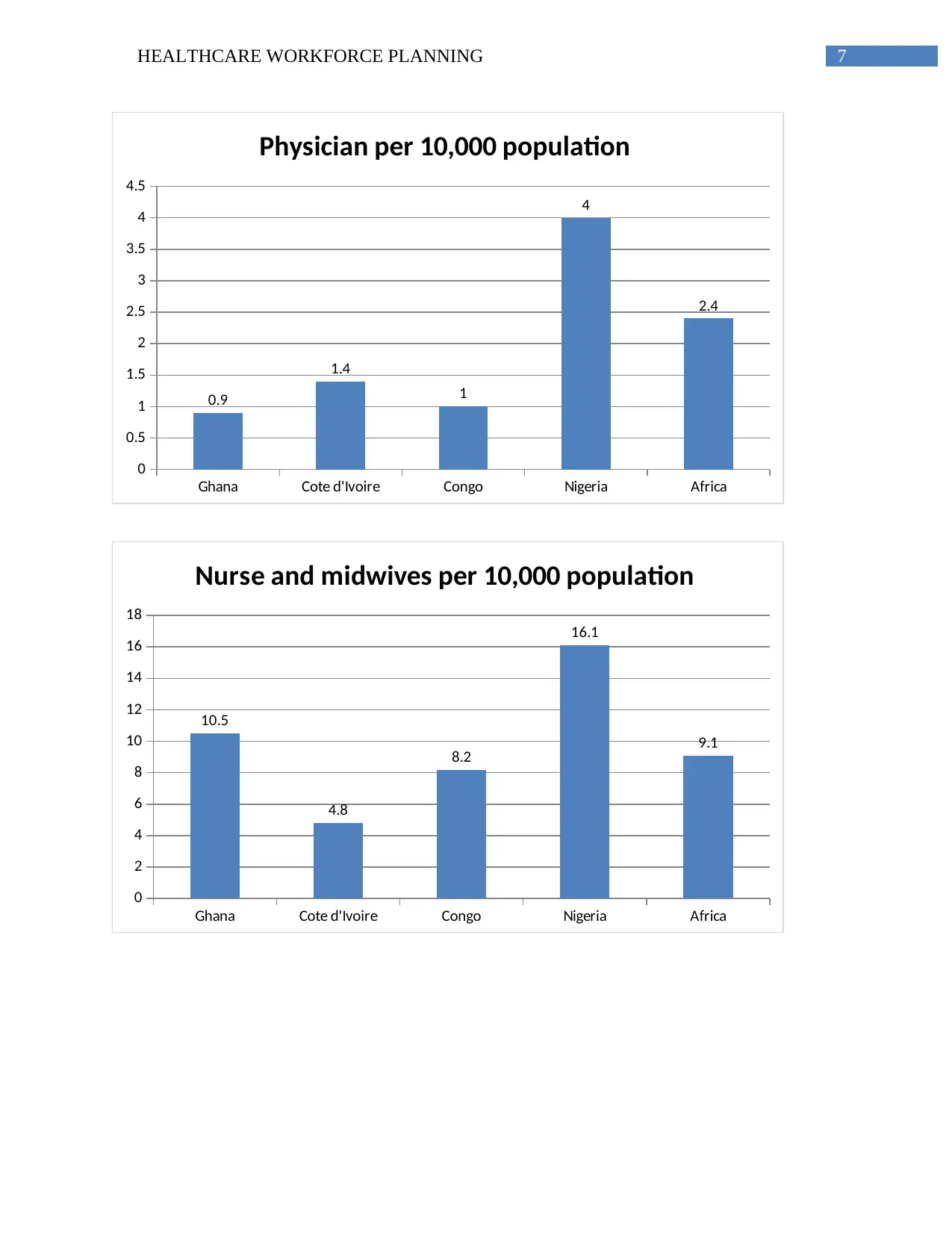
7HEALTHCARE WORKFORCE PLANNING
Ghana Cote d'Ivoire Congo Nigeria Africa
0
0.5
1
1.5
2
2.5
3
3.5
4
4.5
0.9
1.4
1
4
2.4
Physician per 10,000 population
Ghana Cote d'Ivoire Congo Nigeria Africa
0
2
4
6
8
10
12
14
16
18
10.5
4.8
8.2
16.1
9.1
Nurse and midwives per 10,000 population
Ghana Cote d'Ivoire Congo Nigeria Africa
0
0.5
1
1.5
2
2.5
3
3.5
4
4.5
0.9
1.4
1
4
2.4
Physician per 10,000 population
Ghana Cote d'Ivoire Congo Nigeria Africa
0
2
4
6
8
10
12
14
16
18
10.5
4.8
8.2
16.1
9.1
Nurse and midwives per 10,000 population
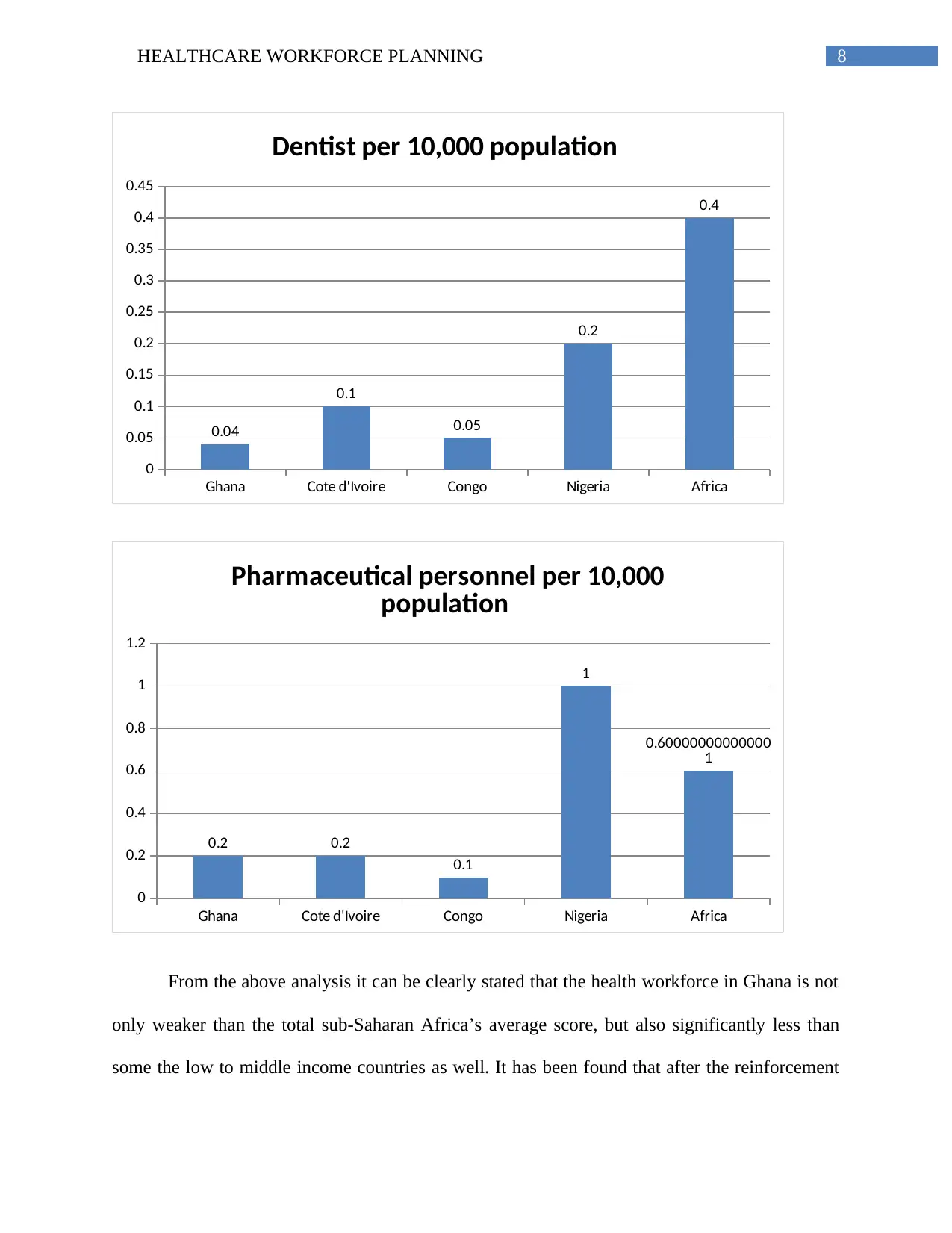
8HEALTHCARE WORKFORCE PLANNING
Ghana Cote d'Ivoire Congo Nigeria Africa
0
0.05
0.1
0.15
0.2
0.25
0.3
0.35
0.4
0.45
0.04
0.1
0.05
0.2
0.4
Dentist per 10,000 population
Ghana Cote d'Ivoire Congo Nigeria Africa
0
0.2
0.4
0.6
0.8
1
1.2
0.2 0.2
0.1
1
0.60000000000000
1
Pharmaceutical personnel per 10,000
population
From the above analysis it can be clearly stated that the health workforce in Ghana is not
only weaker than the total sub-Saharan Africa’s average score, but also significantly less than
some the low to middle income countries as well. It has been found that after the reinforcement
Ghana Cote d'Ivoire Congo Nigeria Africa
0
0.05
0.1
0.15
0.2
0.25
0.3
0.35
0.4
0.45
0.04
0.1
0.05
0.2
0.4
Dentist per 10,000 population
Ghana Cote d'Ivoire Congo Nigeria Africa
0
0.2
0.4
0.6
0.8
1
1.2
0.2 0.2
0.1
1
0.60000000000000
1
Pharmaceutical personnel per 10,000
population
From the above analysis it can be clearly stated that the health workforce in Ghana is not
only weaker than the total sub-Saharan Africa’s average score, but also significantly less than
some the low to middle income countries as well. It has been found that after the reinforcement
⊘ This is a preview!⊘
Do you want full access?
Subscribe today to unlock all pages.

Trusted by 1+ million students worldwide
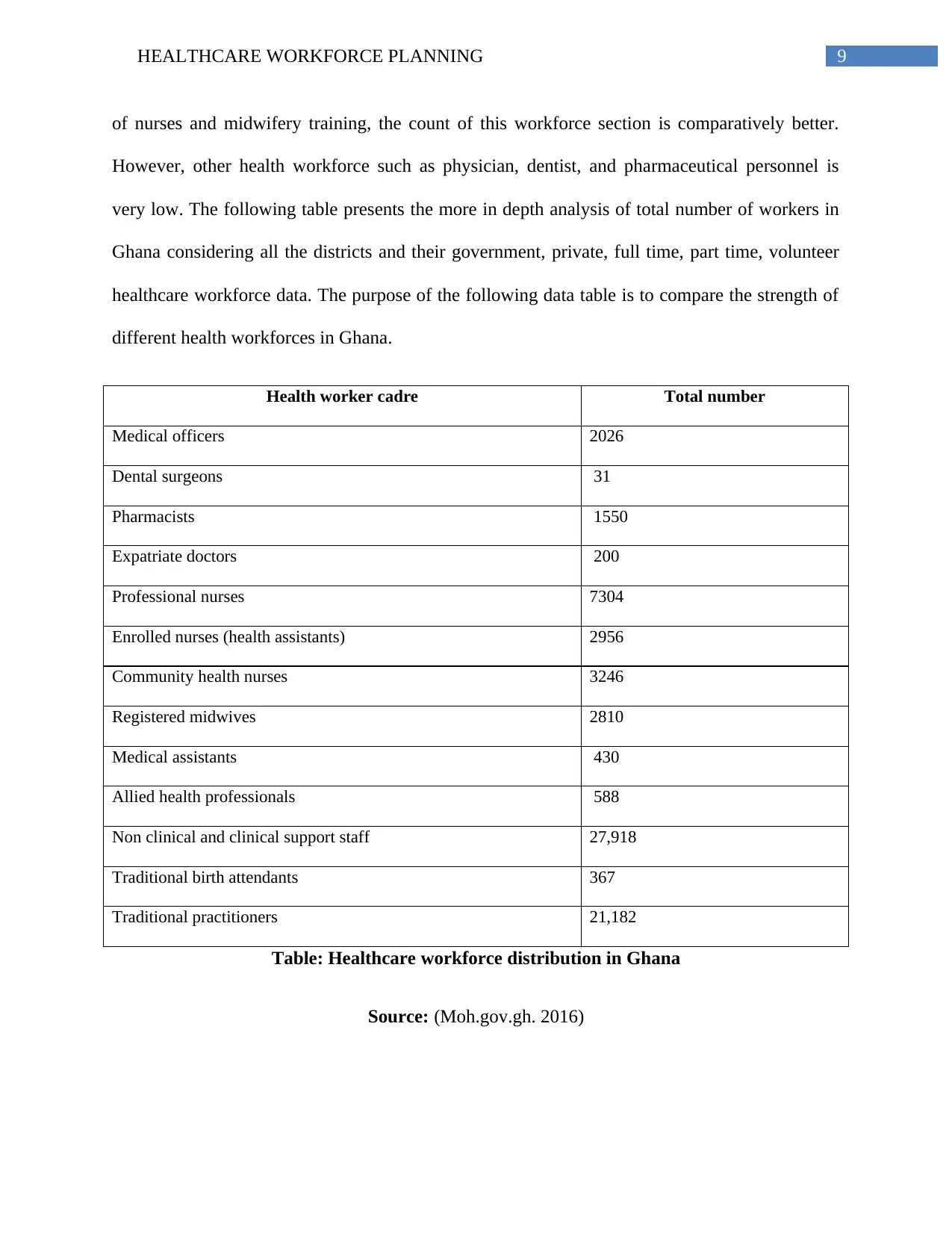
9HEALTHCARE WORKFORCE PLANNING
of nurses and midwifery training, the count of this workforce section is comparatively better.
However, other health workforce such as physician, dentist, and pharmaceutical personnel is
very low. The following table presents the more in depth analysis of total number of workers in
Ghana considering all the districts and their government, private, full time, part time, volunteer
healthcare workforce data. The purpose of the following data table is to compare the strength of
different health workforces in Ghana.
Health worker cadre Total number
Medical officers 2026
Dental surgeons 31
Pharmacists 1550
Expatriate doctors 200
Professional nurses 7304
Enrolled nurses (health assistants) 2956
Community health nurses 3246
Registered midwives 2810
Medical assistants 430
Allied health professionals 588
Non clinical and clinical support staff 27,918
Traditional birth attendants 367
Traditional practitioners 21,182
Table: Healthcare workforce distribution in Ghana
Source: (Moh.gov.gh. 2016)
of nurses and midwifery training, the count of this workforce section is comparatively better.
However, other health workforce such as physician, dentist, and pharmaceutical personnel is
very low. The following table presents the more in depth analysis of total number of workers in
Ghana considering all the districts and their government, private, full time, part time, volunteer
healthcare workforce data. The purpose of the following data table is to compare the strength of
different health workforces in Ghana.
Health worker cadre Total number
Medical officers 2026
Dental surgeons 31
Pharmacists 1550
Expatriate doctors 200
Professional nurses 7304
Enrolled nurses (health assistants) 2956
Community health nurses 3246
Registered midwives 2810
Medical assistants 430
Allied health professionals 588
Non clinical and clinical support staff 27,918
Traditional birth attendants 367
Traditional practitioners 21,182
Table: Healthcare workforce distribution in Ghana
Source: (Moh.gov.gh. 2016)
Paraphrase This Document
Need a fresh take? Get an instant paraphrase of this document with our AI Paraphraser
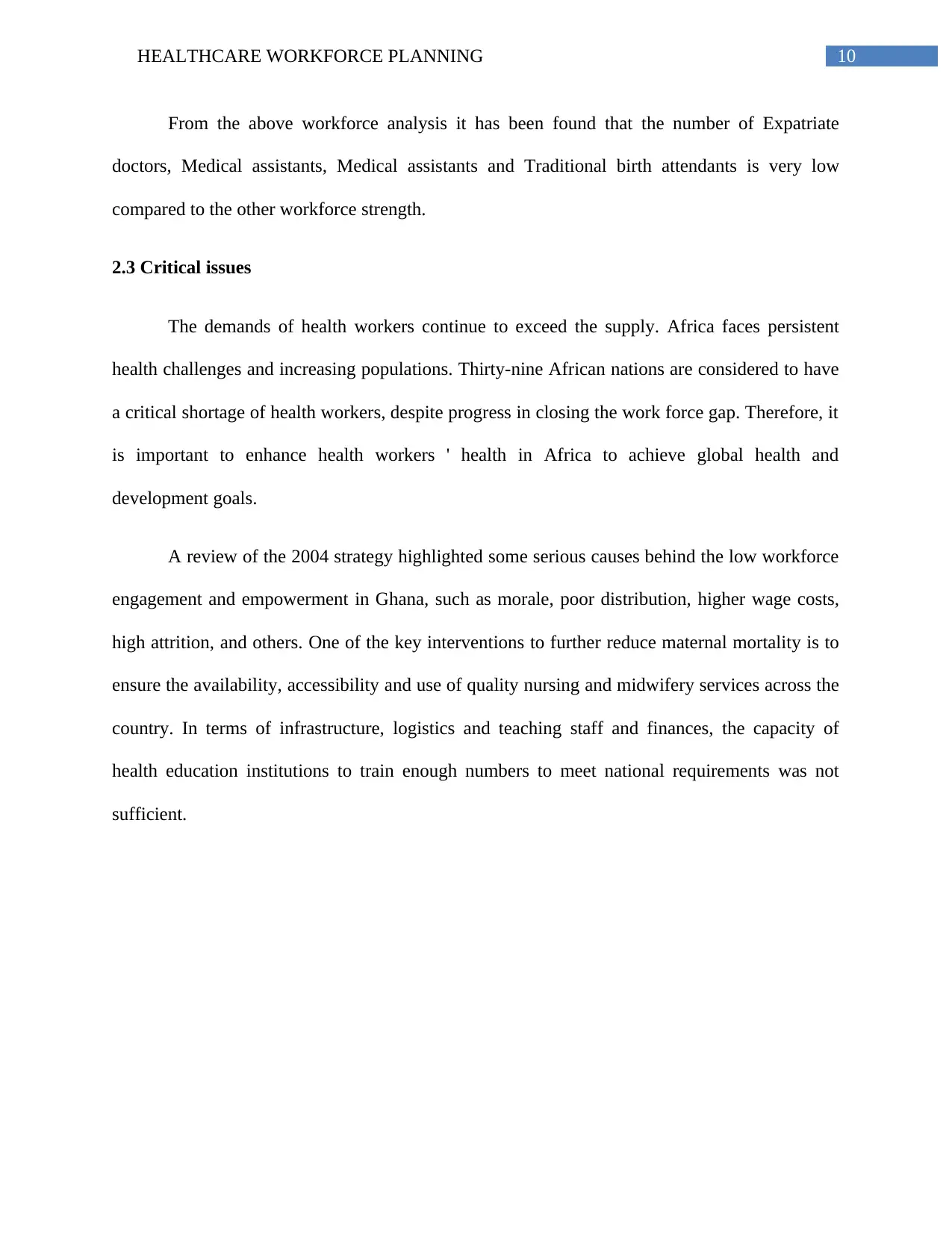
10HEALTHCARE WORKFORCE PLANNING
From the above workforce analysis it has been found that the number of Expatriate
doctors, Medical assistants, Medical assistants and Traditional birth attendants is very low
compared to the other workforce strength.
2.3 Critical issues
The demands of health workers continue to exceed the supply. Africa faces persistent
health challenges and increasing populations. Thirty-nine African nations are considered to have
a critical shortage of health workers, despite progress in closing the work force gap. Therefore, it
is important to enhance health workers ' health in Africa to achieve global health and
development goals.
A review of the 2004 strategy highlighted some serious causes behind the low workforce
engagement and empowerment in Ghana, such as morale, poor distribution, higher wage costs,
high attrition, and others. One of the key interventions to further reduce maternal mortality is to
ensure the availability, accessibility and use of quality nursing and midwifery services across the
country. In terms of infrastructure, logistics and teaching staff and finances, the capacity of
health education institutions to train enough numbers to meet national requirements was not
sufficient.
From the above workforce analysis it has been found that the number of Expatriate
doctors, Medical assistants, Medical assistants and Traditional birth attendants is very low
compared to the other workforce strength.
2.3 Critical issues
The demands of health workers continue to exceed the supply. Africa faces persistent
health challenges and increasing populations. Thirty-nine African nations are considered to have
a critical shortage of health workers, despite progress in closing the work force gap. Therefore, it
is important to enhance health workers ' health in Africa to achieve global health and
development goals.
A review of the 2004 strategy highlighted some serious causes behind the low workforce
engagement and empowerment in Ghana, such as morale, poor distribution, higher wage costs,
high attrition, and others. One of the key interventions to further reduce maternal mortality is to
ensure the availability, accessibility and use of quality nursing and midwifery services across the
country. In terms of infrastructure, logistics and teaching staff and finances, the capacity of
health education institutions to train enough numbers to meet national requirements was not
sufficient.
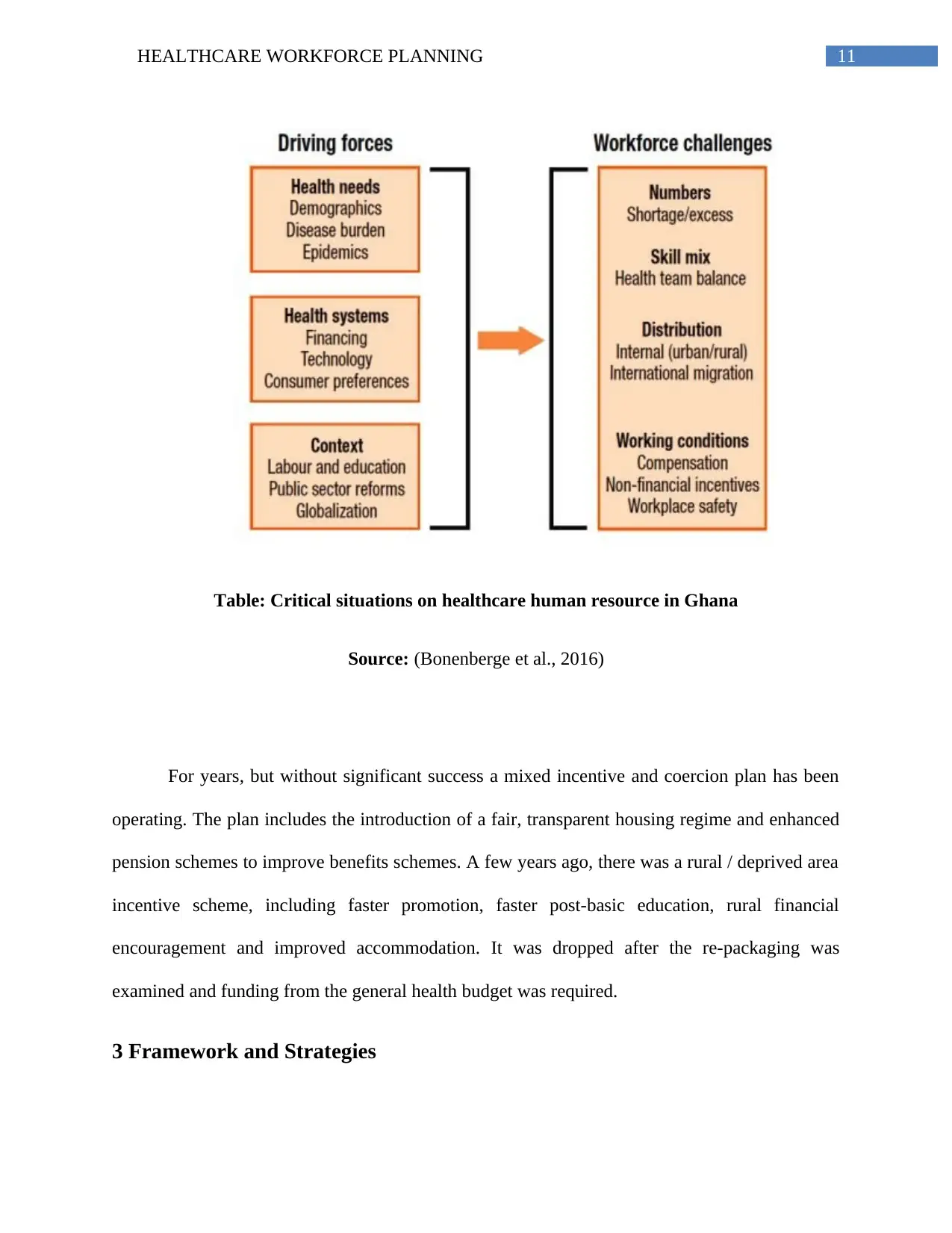
11HEALTHCARE WORKFORCE PLANNING
Table: Critical situations on healthcare human resource in Ghana
Source: (Bonenberge et al., 2016)
For years, but without significant success a mixed incentive and coercion plan has been
operating. The plan includes the introduction of a fair, transparent housing regime and enhanced
pension schemes to improve benefits schemes. A few years ago, there was a rural / deprived area
incentive scheme, including faster promotion, faster post-basic education, rural financial
encouragement and improved accommodation. It was dropped after the re-packaging was
examined and funding from the general health budget was required.
3 Framework and Strategies
Table: Critical situations on healthcare human resource in Ghana
Source: (Bonenberge et al., 2016)
For years, but without significant success a mixed incentive and coercion plan has been
operating. The plan includes the introduction of a fair, transparent housing regime and enhanced
pension schemes to improve benefits schemes. A few years ago, there was a rural / deprived area
incentive scheme, including faster promotion, faster post-basic education, rural financial
encouragement and improved accommodation. It was dropped after the re-packaging was
examined and funding from the general health budget was required.
3 Framework and Strategies
⊘ This is a preview!⊘
Do you want full access?
Subscribe today to unlock all pages.

Trusted by 1+ million students worldwide
1 out of 19
Related Documents
Your All-in-One AI-Powered Toolkit for Academic Success.
+13062052269
info@desklib.com
Available 24*7 on WhatsApp / Email
![[object Object]](/_next/static/media/star-bottom.7253800d.svg)
Unlock your academic potential
Copyright © 2020–2025 A2Z Services. All Rights Reserved. Developed and managed by ZUCOL.





